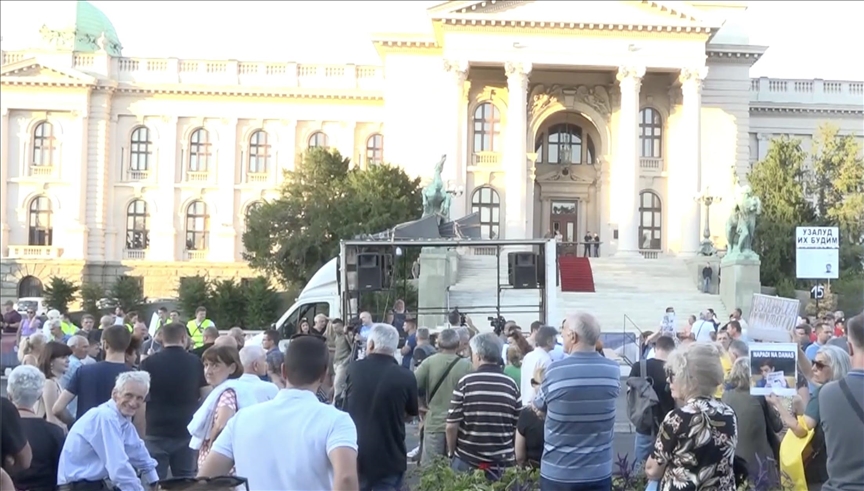Douglas Guzman takes video with his smartphone at Liberty Plaza in San Salvador, El Salvador, Saturday, June 24, 2023. Guzmán is part of a network of social media personalities acting as a megaphone for, and cashing in on, El Salvador President Nayib Bukele’s message. (AP Photo/Salvador Melendez)
Douglas Guzman shows his press credentials for content creator before filming at Plaza Libertad in San Salvador, El Salvador, Saturday, June 24, 2023. Guzmán and other social media influencers said access to the legislative body was empowering to them, enabling them to grow their audiences with political content. (AP Photo/Salvador Melendez)
An avatar of El Salvador’s President Nayib Bukele is projected on a giant screen during the closing ceremony of a congress for cryptocurrency investors, in Santa Maria Mizata, El Salvador, Nov. 20, 2021. After working years in political advertising, social media was key to Bukele’s rise to power five years ago. (AP Photo/Salvador Melendez, File)
People film with their mobile devices at Plaza Libertad in San Salvador, El Salvador, Saturday, June 24, 2023. In April, the President of El Salvador’s congress Ernesto Castro announced he would open the legislative body to YouTubers and social media content creators so they could “inform with objectivity”. (AP Photo/Salvador Melendez)
BY MEGAN JANETSKY
August 12, 2023Share
SAN SALVADOR, El Salvador (AP) — Douglas Guzmán’s TikTok feed was dotted with workout routines and videos showcasing his favorite parts of his country.
That changed about a year ago, as rights groups, civil society and even some officials criticized El Salvador’s President Nayib Bukele for violating human rights in his crackdown on criminal gangs, and said that his unconstitutional bid for re-election would corrode the country’s democracy.
Within days of Bukele announcing his bid for a second five-year term, Guzmán’s feed was plastered with videos describing Bukele as the “future liberator of Latin America” and slick montages of the leader’s “mega-prison” for accused gangsters.
Views on the social media influencer’s videos skyrocketed. The 39-year-old member of Bukele’s party said he found a new mission: counteracting negative press from independent media about his populist president.
El Salvador plans mass trials for those imprisoned in gang crackdown
“(Journalists) don’t know anything. All they do is sit at their desks and watch as President Bukele … makes a massive effort to save thousands of lives. But they don’t see that because they’ve never cared about the lives of Salvadorans,” Guzmán said. “That’s why we’re here. To show the true reality.”
Guzmán is part of an expanding network of social media personalities acting as a megaphone for the millennial leader. At the same time Bukele has cracked down on the press, his government has embraced those influencers. As the president seeks to hold onto power, he has harnessed that flood of pro-Bukele content slowly turning his Central American nation into an informational echo chamber.
“A news organization doing an investigation can’t compare to the sounding board that these influencers have because they flood your social media with the government’s narrative,” said Roberto Dubon, a communications strategist and congressional candidate for Bukele’s former party, FMLN. “What you have is an apparatus to spread their propaganda.”
Bukele, a 42-year-old leader often donning a backwards baseball cap, worked years in political advertising before social media became a key to his rise to power five years ago. Since, his approval ratings have soared to 90%, according to a June CID Gallup poll. Bukele’s modern political messaging, charisma and brutal crackdown on the country’s gangs only continue to win him fans domestically and abroad even in the midst of controversy
By doing so, Bukele is using a playbook increasingly utilized by 21st century autocrats, said Seva Gunitsky, a political scientist at the University of Toronto.
Social media was once hailed as the ultimate democratic tool to organize protests, even revolutions, across the world. Now, governments from Russia to Uganda are now using it to control the narrative.
“They use this tool of liberation technology to actually prolong and strengthen their rule,” Gunitsky said. Such governments use influencers because their content “doesn’t look as much like propaganda and is more about shaping the narrative in more subtle ways.”
Under Bukele, El Salvador constructed a sophisticated communications machine. It locked down access to information out of line with official messaging and hired teams of former journalists to produce blockbuster-quality videos showcasing security forces taking on the nation’s gangs. The government also mimicked Russia, building an army of tech-savvy contractors – or “trolls” – to create fake social media accounts, spread falsities and harass critics.
At the same time his message of a strong-handed response to gang violence rippled across the region, gaining traction in other nations struggling with crime across Latin America and Caribbean.
With it, an “entire industry” has been born as influencers latch onto the president’s image, said Oscar Picardo, director of investigations at El Salvador’s Universidad Francisco Gavidia.
A study by Picardo’s university and local investigative outlet Factum examined 69 pro-Bukele YouTube accounts, which collectively have more followers than the population of El Salvador. They found many accounts – which make money through view and subscriber counts – can earn up to tens of thousands of dollars a month, far greater than El Salvador’s average salary. That content is devoured both within El Salvador, and by many of the 2.3 million Salvadorans living in the United States.
The cluster of accounts pumped out nearly 32 hours of pro-Bukele content in a single day in May, the study found. Almost always mirroring government language, 90% of the videos analyzed contained false or misleading information.
One account, Noticias Cuscatlecas, may earn much as $400,000 annually posting videos of violent attacks from alleged gang members layered over chilling music, UFG and Factum calculated.
The channel often concludes videos with the same message: “(Bukele) devised a plan to exterminate this cancer from society, and the incredible thing is that he is succeeding. Now the people no longer live in fear.”
On TikTok, one video declares “God chose Bukele as president of El Salvador.” On YouTube, personalities dressed as TV anchors attack human rights groups and journalists. They feature Bukele’s critics bursting into flames while claiming their channel “brings you the latest news”. Others sit down for an exclusive interview with the president.
In April, the president of El Salvador’s congress Ernesto Castro announced he was opening the assembly to YouTubers and social media influencers to “inform with objectivity.”
“The right to inform and be informed is a power not just in the hands of media companies,” Castro wrote on Twitter.
Requests by the AP for interviews with Bukele and his cabinet throughout his more than four years in office have been declined or ignored. Two people with knowledge of the inner workings of Bukele’s media machine declined to speak to the AP out of fear of the government.
For Guzmán and others, the access was empowering, enabling them to grow their audiences. Since, Guzmán has been offered access to other large events like the inauguration of Central American and Caribbean Games, something experts say Bukele used to show a friendly face to the world
Press credentials hung around the TikToker’s neck and he brimmed with pride in a government press box, standing among other selfie stick-wielding influencers.
“Us being here, accredited, I feel like I am a part of this,” Guzmán said, eyes crinkling with a broad smile.
Around him, others took turns interviewing each other and bragged about how many people were connected to their feeds. One man wearing a Hawaiian shirt leapt over rows of bleachers to get a better signal. When Bukele walked on stage to give a speech, Guzmán and others chanted “Re-election!”
El Salvador’s government is not the first to open its doors to social media personalities, but researchers and critics says the atmosphere created in El Salvador marks a particular risk as other leaders in the region seek to mimic Bukele.
Picardo, the UFG investigator, said such accounts post a deluge of content when the government is trying to publicize something, like the leader’s experiment with Bitcoin, its gang crackdown or the Games.
The researcher warned their increasingly hostile tone acts as a harbinger for further deteriorating press freedoms, echoing State Department alarms of a “villainization” of journalists by Bukele.
Oscar Martínez’s award-winning news organization El Faro is among those facing attacks and harassment for its intensive investigation of Bukele, including audio evidencing that Bukele’s administration negotiated with gangs in order to dip violence.
The government opened a case against El Faro for tax evasion, something the news site called “ completely baseless.” Phones of dozens of journalists were hacked with Pegasus spyware, regularly used by governments to spy on opponents.
In April, El Faro announced it would move its center of operations to Costa Rica due to escalating harassment.
He worries their investigations is being drowned out by the flood of disinformation, and said if Bukele stays in power in the upcoming elections, it will put reporters in El Salvador “much more at risk.”
“At that moment, Bukele is going to decide to get rid of any obstacle he has within the country, and the main obstacle he has right now is the free press,” Martínez said.










![Girl, 3, dies on a migrant bus heading for Chicago [file photo]](https://ichef.bbci.co.uk/news/976/cpsprodpb/FA8A/production/_130783146_venezuelabus.jpg)